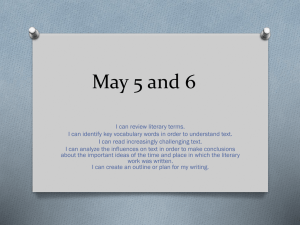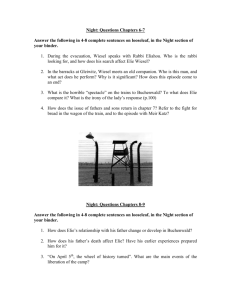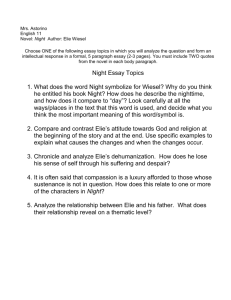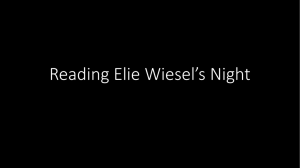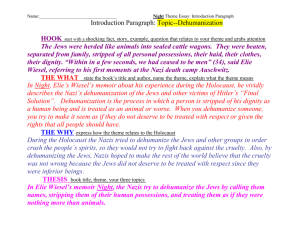Lesson Plan Document
advertisement
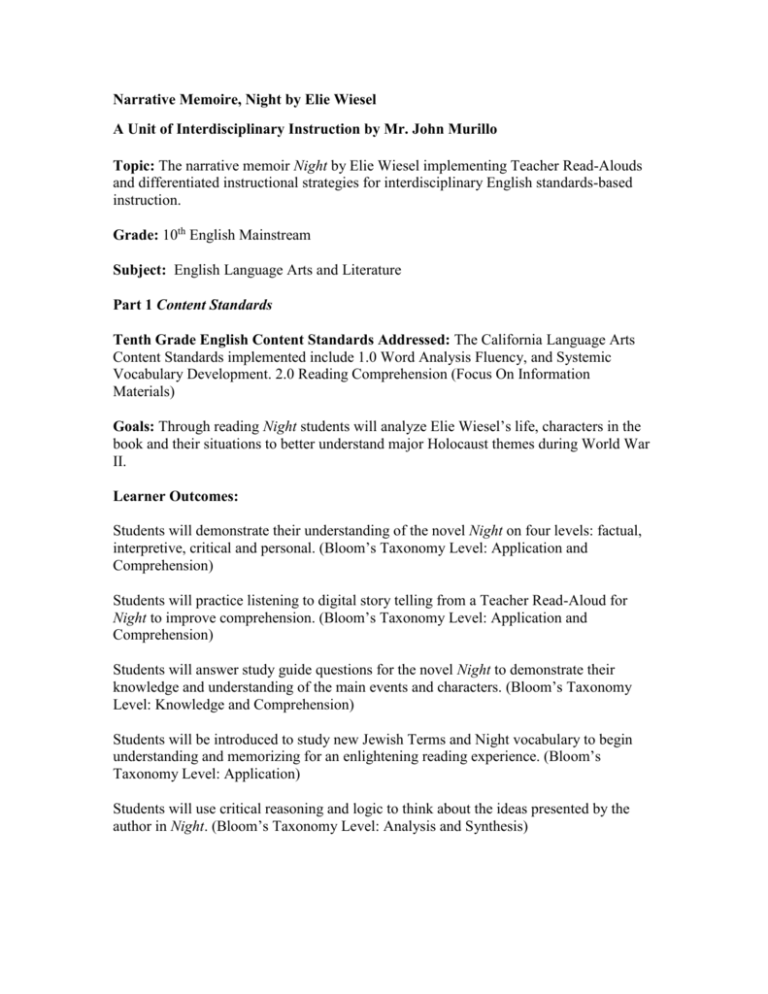
Narrative Memoire, Night by Elie Wiesel A Unit of Interdisciplinary Instruction by Mr. John Murillo Topic: The narrative memoir Night by Elie Wiesel implementing Teacher Read-Alouds and differentiated instructional strategies for interdisciplinary English standards-based instruction. Grade: 10th English Mainstream Subject: English Language Arts and Literature Part 1 Content Standards Tenth Grade English Content Standards Addressed: The California Language Arts Content Standards implemented include 1.0 Word Analysis Fluency, and Systemic Vocabulary Development. 2.0 Reading Comprehension (Focus On Information Materials) Goals: Through reading Night students will analyze Elie Wiesel’s life, characters in the book and their situations to better understand major Holocaust themes during World War II. Learner Outcomes: Students will demonstrate their understanding of the novel Night on four levels: factual, interpretive, critical and personal. (Bloom’s Taxonomy Level: Application and Comprehension) Students will practice listening to digital story telling from a Teacher Read-Aloud for Night to improve comprehension. (Bloom’s Taxonomy Level: Application and Comprehension) Students will answer study guide questions for the novel Night to demonstrate their knowledge and understanding of the main events and characters. (Bloom’s Taxonomy Level: Knowledge and Comprehension) Students will be introduced to study new Jewish Terms and Night vocabulary to begin understanding and memorizing for an enlightening reading experience. (Bloom’s Taxonomy Level: Application) Students will use critical reasoning and logic to think about the ideas presented by the author in Night. (Bloom’s Taxonomy Level: Analysis and Synthesis) Students will have a deeper understanding of Elie Wiesel’s life in Sighet, the experience of Jewish prisoners in the ghettos, and the horrifying conditions in concentration camps. (Bloom’s Taxonomy Level: Analysis and Comprehension) Students will practice using the Cornell system for writing notes on Night. The Cornell system of note taking is focused on several purposes: 1. To check the student’s reading comprehension. 2. To make students think about the ideas presented by the novel. 3. To make students put those ideas into perspective. 4. To encourage critical and logical thinking. 5. To provide the opportunity to practice good grammar and improve student’s use of the English language. (Bloom’s Taxonomy Level: Application) Tenth Grade History-Social Science Content Standards 10.8: Students analyze the causes and consequences of the World War II. Write Responses to Literature by blogging. Students will discuss the human costs of the war, with particular attention to the civilian and military losses in Russia, Germany, Britain, the United States, China, and Japan. (Bloom’s Taxonomy Level: Analysis, Comprehension and Application) Students will analyze the Nazi policy of pursuing racial purity, especially against the European Jews; its transformation into the Final Solution; and the Holocaust that resulted in the murder of six million Jewish civilians. (Bloom’s Taxonomy Level: Analysis and Comprehension) Learner Outcomes: Students will collaborate to engage in writing a blog for creating a persuasive letter to either Adolf Hitler or one of his many generals in command to attempt to persuade either one of them to avoid escalating World War II and the extermination of millions of innocent Jews in Europe. Towards the end of this creative digital writing project, students will engage in a right brained activity for developing imagination by discussing, “What if questions.” (Bloom’s Taxonomy Level: Application, Evaluation and Synthesis) MATERIALS AND TOOLS Technologies: A desktop computer with Microsoft PowerPoint 2010 software, the World Wide Web (Internet), student notebooks, color pens and pencils. Visuals: Black and White photos of Elie Wiesel during the Holocaust. Texts: A class set of the narrative memoir Night by Elie Wiesel. Student materials: A copy of the narrative memoir Night by Elie Wiesel, Night Study Guide, a list of ten tier 2 vocabulary words on Night, a pencil or pen, and a journal notebook. Basic Vocabulary: Usage of Standard American English Part 2: Chunks The teacher will direct all students to prepare for the teacher’s Teacher ReadAloud presentation by implementing advanced expository organizer using Microsoft Power Point 2010 software for a Night PowerPoint presentation. Thereafter, the teacher implements Specially Designed Academic Instruction in English (SDAIE) methods for answering the Interdisciplinary Night Study Guide questions. Students will summarize and take notes during this section of the lesson, expected to last 10-15 minutes. Thereafter, students will analyze the causes and consequences of the World War II as part of the Tenth Grade History-Social Science Content Standards 10.8. Towards the end of completing the Night Study Guide, students will discuss the following What if questions such as, What if World War II did not happen: what effect would this have today? What if the Germans had won the war: how might our lives be different today? And what if the United States and Germany were to have a war in the year 2012? What similarities and differences do you see between it and World War II in the 1940’s? Part 3: Differentiated Instructional Strategies for Interdisciplinary Teach, Practice and Apply Differentiated instruction for tenth grade English Language Learners is facilitated and enabled by having students implement the Copycatting Strategy as they discover and copy simple sentences from the narrative memoir Night to fill in the blank squares of the Active Reading Interdisciplinary Night Study Guide presented with the Point-of-View Guide model at the end of this lesson plan. Dr. Ventriglia has written a passage subtitled, Strategy: Adjusting Questions to English Language Proficiency Levels which states, The Strategy of Adjusting Questioning For English Language Proficiency Levels can be used to target comprehension questions at appropriate levels” (Ventriglia, 2010, page 94). In order to facilitate teachers with effective Best Practices that differentiate instruction for my students, I will implement several grouping patterns determined by the learning objectives, student readiness, and teacher judgment. More specifically, there are three highly effective Best Practice grouping designs teachers can implement to enhance student learning: Whole-group (the teacher instructs the whole class of students in one session), small group (small groups of students are led by a designated student “Team Leader” for achieving learning of an assigned task), and peer pairs (a group consisting of two students assigned to achieve a learning task). Part 4: Pre-Assessment Activity Before we begin reading the narrative memoir Night and analyze Elie Wiesel’s life, characters in the book and their situations to better understand major Holocaust themes during World War II, it is important to assess my student’s readiness levels; therefore, I will assign a quick write whereby students briefly write about what they learned in middle school about this subject. Dr. Ventriglia explains, “The preassessment reveals what students know about the topic and the skills they have mastered in the content standards” (Ventriglia, 2010, page 20). Upon completing my quick write assessment review of what my students actually know or have not learned in middle school, I am better prepared to differentiate instruction to accommodate varying levels of readiness. In fact, Dr. Ventriglia reveals, “A Quick Write differentiates instruction because students write at their levels of proficiency” (Ventriglia, 2010, page 69). Part 5: Teach English Literature: The English teacher situates himself near the middle of the classroom below the ceiling mounted digital video projector that illuminates the Microsoft Power Point 2010 presentation. The teacher reads the Interdisciplinary Night Study Guide questions aloud slowly and asks students to follow along silently reading. Students may write their first-language equivalents together with new words in their vocabulary list or notebook. Differentiated instruction for tenth grade English Language Learners is facilitated and enabled by having students implement the Copycatting Strategy as they discover and copy simple sentences from the narrative memoir text Night to fill in the blank squares of the Active Reading Interdisciplinary Night Study Guide Table within the following Point-of-View Guide model presented at the end of this lesson plan report. Demonstrate and Model: The entire class prepares to observe and listen attentively to the Night Power Point. The English teacher announces, “If anyone develops concerns or questions during this Teacher Read-Aloud please write down your concerns or questions and wait until after my presentation is complete. Please remember to use your background knowledge from your scanning preparation of the Active Reading Interdisciplinary Night Study Guide and now you may begin observing the words and listening to my introduction presentation of Night for about 15-20 minutes.” Teacher presentation of digital story telling video clip: The teacher slowly articulates aloud, “First, I will begin by implementing the use of an online Night PowerPoint presentation which includes a description stating, “An introduction to Night, which covers historical background, including the rise of Nazism, Nazi propaganda, and quotes to prompt a discussion of nationalism. In addition, the second-to-last slide offers a list of motifs that can be used for dialectical journals or literature circles” (enotes.com, Night PowerPoint). Please look at the screen as I display digital scaffolding illustrations and elucidations for comprehending Night and especially during my brief reading performance of Chapter 1.” Check for Understanding: “Does everyone understand what this Teacher Read-Aloud session is enabling you to do? Is there any misunderstanding or confusion from the Night PowerPoint and the specific goals and objectives you are going to meet?” Social Science: Towards the end of the web-based Active Reading Interdisciplinary Night Study Guide students will commence to implement a blog for writing a persuasive letter to either Adolf Hitler or one of his many generals in command to attempt to persuade either one of them to avoid escalating World War II and the extermination of millions of innocent Jews in Europe. Both writing a persuasive letter (Writing Applications 2.4 standard; Languages Arts) and knowing the causes and consequences of the World War II (HSS Content Standards 10.8; Socials Studies) are key tenth grade standards. Near the end of this creative digital writing project, students will engage in a conceptual right brained activity for developing imagination by discussing the following What if questions such as What if World War II did not happen: what effect would this have today? What if the Germans had won the war: how might our lives be different today? And what if the United States and Germany were to have a war in the year 2012? What similarities and differences do you see between it and World War II in the 1940’s? Students may use their social studies textbook as well as the World Wide Web to research and blog the causes of World War II, description of European life during the 1930’s and 1940’s, the character of Adolf Hitler and his top generals in command, various rhetorical methods to dissuade war and incorporate them in writing letters, and any other plausible areas students can think about that may facilitate them in their journey. Part 6: Practice English Literature: Thereafter, the English teacher initiates organizational walk-throughs by circulating the classroom in search of students who have completed their Cornell notes. During this time the English teacher encourages students to create a heterogeneous collaboration in the spirit of Cooperative Learning for discussion and asking questions among each other. Students will demonstrate how whole groups, small groups, and peer pairs can be implemented as a highly effective Best Practice for differentiating instruction that targets different learning styles and accelerates student achievement in learning the tenth grade English Language Arts Standard for vocabulary development of the narrative memoir Night by Elie Wiesel. More specifically, the one standard we will work on for The California Language Arts Content Standards includes the following: 1.0 Word Analysis Fluency, and Systemic Vocabulary Development. The learner outcome for this Standards-based lesson is as follows: Students will be introduced to study ten Night vocabulary words and five cognate words relating to the narrative memoir to begin understanding, reflecting and rehearsing these words for an enlightening reading experience. (Bloom’s Taxonomy Level: Application) Part 7: Apply Whole Group Dr. Ventriglia reveals, “Whole group instruction enables the teacher to give students common understanding and a sense of community. All students can share in blog discussions and contribute their diverse background knowledge to the understanding of content concepts” (Ventriglia, 2010, page 5). I plan on implementing the whole group pattern with a direct instruction method that incorporates The Rule of 3 techniques for teaching content vocabulary. The following table presents ten tier 2 words and five cognate words that are intended for students to learn interdisciplinary vocabulary words for reading the narrative memoir Night by Elie Wiesel. Before students commence reading beyond chapter three in Night, it is important the whole group of students understands these words from my direct instruction. The ten vocabulary words are repeated throughout Night so students should understand the meaning of these words early. Word: Parts of Definition: Example: Speech: abominable adjective Repugnantly Most old trash hateful; detestable; produces an loathsome: an abominable abominable crime. odor. anecdotes noun a short account of a particular incident or event, especially of an interesting or amusing nature. deportation noun The lawful expulsion of an undesired alien or other person from a state. diplomacy Skill in managing negotiations, handling people, etc., so that there is little or no ill noun Other Info.: Sentence Use: Antonym: When Elie likable, Wiesel admirable. 2. arrived in delightful. Aushwitz, he smelled a(n) abominable odor of burning flesh. During road Synonym: While on the trips most story, yarn, train to friends and reminiscence. Aushwitz, family share some Jews anecdotes to may have comfort each shared other. anecdotes with each other in order to pass the time and comfort their spirits. Undocumented Synonym: When Jews immigrants are removal were forced deported by the to leave their immigration homes in department. Sighet, they experienced what was called deportation. Most hard core Synonym: The Jews thugs do not negotiation were unable believe in to negotiate practicing with the diplomacy. Nazis about Fascist noun Gestapo noun ghetto noun hermetically adverb pious will; tact: Seating one’s dinner guests often calls for considerable diplomacy. A person who is dictatorial or has extreme rightwing views. The German state secret police during the Nazi regime, organized in 1933 and was notorious for its brutal methods and operations. Formerly, in most European countries) a section of a city in which all Jews were required to live. so as to be airtight: adjective Having or showing a dutiful spirit of reverence for god or an earnest wish to fulfill religious obligations. deportation; therefore, there was no diplomacy. Fascist leaders Synonym: demand authoritarian absolute obedience. Gestapo tactics Synonym: are similar to secret state police police brutality. Mr. Murillo Synonym: a grew up in a densely New York City populated ghetto because slum area of a he was poor city inhabited most of his life. by a socially and economically deprived minority Some candy Antonym: bars are unsealed hermetically sealed to preserve freshness. As a young catholic, Mr. Murillo was very pious. A fascist is a person who believes a dictatorship is a good form of government. “Gestapo tactics” in general are intimidating official procedures. Before the Jews were forced out of Sighet, they were moved to small, isolated areas of the city known as ghettos. When the Jews were forced onto a cattle car of the train, the doors were hermetically sealed. Synonym: In the devout, godly, beginning of reverent the novel, Elie Wiesel seemed to be a very pious young man because he rabbi noun Cognates Spanish Cognate absoluto Unrestrained or unlimited by a constitution, counterbalancing group, etc., in the exercise of governmental power. biografia a written account of another person’s life: absolute biography calm calmar edict edicto family familia the religious leader of a congregation; the minister of a synagogue Most rabbi Synonym: leaders are priest very intelligent scholars. wanted to study the cabbala. A rabbi is a type of Jewish religious instructor. Fidel Castro is Synonyms: a modern autocratic, absolute tyrant. dictatorial, totalitarian Hitler was an absolute monster that murdered innocent Jews. Someone wrote Synonym: a biography memoir about Adolf Hitler’s life. A writer wrote a biography about Elie Weisel’s life. Well behaved children remain calm under pressure. Hitler created an edict to commit mass genocide of the Jews. Many Jewish families suffered during the Holocaust. Free from Mr. Murillo excitement or remains calm passion; tranquil: in the presence a calm face; a of danger. calm manner. A decree issued by Libiyan a sovereign or president other authority. Kadafi enacted an edict to stop rebels protests. A basic social unit Elie Wiesel consisting of mourned the parents and their loss of his children, family during considered as a the Holocaust. group, whether dwelling together or not: the traditional family. Synonyms: harmonious Synonyms: directive Synonyms: lineage In the above list of interdisciplinary vocabulary words, the last five words listed are cognates and are related to the topic of the narrative memoir Night by Elie Wiesel. The five cognate words were selected from a list of cognates, which are words that facilitate the development of dual functioning English and Spanish language vocabulary words; cognate words sound the same and have comparable meaning in both English and Spanish. In fact, including cognates in the vocabulary list facilitates students who are studying either language (Ventriglia, 2009, page 218-219). Small Group Dr. Linda D. Ventriglia reveals, “Students who have similar learning needs can be grouped together to target content standards. English language learners can be grouped for a lesson using teaching strategies that accelerate access to the core curriculum and also develop English language proficiencies” (Ventriglia, 2010, page 5). Students will be encouraged to engage in small heterogeneous collaborations with a Team Leader facilitating the reinforcement of vocabulary retention. More specifically, students will contemplate how a word is associated to their own lives and create a visual representation of the word. I will assign the small heterogeneous groups of students to infuse the Night vocabulary preparation with their art skills for drawing a creative picture of each word. Mnemonic methodology research is presented in the education text book titled, Best Practices: Interdisciplinary Vocabulary Development – The Rule of 3 which reveals, “Mnemonics as a method has the largest amount of data supporting its efficacy; there is little doubt that it works well.... Students create their own meaning through visual illustrations or word associations” (Ventriglia, 2009, page 29). When used as an effective Best Practice strategy, creative production significantly increases vocabulary word retention. Furthermore, in order to facilitate and enable my English students to organize their time and efforts for Night vocabulary word development, I will assign them to design a creative digital journal book with all of their vocabulary words, definitions and illustrative pictures hyperlinked for each vocabulary word that enables them to associate selected words to their own lives. The dedicated vocabulary journal may be used to facilitate students to design semantic maps relating all of the vocabulary words they learned while in my high school English class. Most importantly, the vocabulary journal will be incorporated in other active learning activities for the purpose of reinforcing student achievement in vocabulary development. Peer Pairs The Think-Write-Pair-Share Cooperative Learning Strategy will be implemented with an average English class enrollment of thirty-nine students, and we will brainstorm what synonyms are, and most students will be facilitated to provide at least one plausible example as it relates to the list of ten tier 2 words and five cognate words that are intended for students to learn practical vocabulary words for reading the narrative memoir Night by Elie Wiesel. Step One: I will ask students the open-ended question, “Why do we need to learn about synonyms? What purpose do they serve?” This is the question students were to think about independently. I will give my students approximately two minutes to think about how they will answer this question. Step Two: Students will write down their thoughts and ideas on how they will answer the question on a piece of notebook paper I provided for them. In order for this strategy to work effectively, each student needs to provide a plausible answer to the question (Ventriglia, 2010). Step Three: Once students write down their own thoughts on paper, I will encourage students to collaborate into pairs and have them discuss or blog their individual answers explaining the importance of synonyms. Students will be allowed to write down any additional information they learned from sharing with their partners. Step Four: After students have had some time to discuss their answers in pairs, I will choose a person from each pairing to read-aloud their thoughts and the thoughts of their partner. This is where the students review notes they have written from the dialogue or blog they had with their partners. Dr. Ventriglia reveals that when students do this they are demonstrating that “Accountability is built into the model because each student must report to a partner, and partners must report to the class” (Ventriglia, 2009, page 99). As each student reads aloud, I will write their response on the board. Some of the answers students might respond with include the following: “To make writing sound more interesting” ”So we could do better on standardized tests” “Knowing how to use synonyms makes us better writers” and “If we don’t use synonyms, what we read might be really boring” Interdisciplinary Active Reading Study Guide for Night Chapters 1 and 2 The web-based Night Study Guide proivdes the following instructions: In chapters 1 and 2, a number of significant things happen to Elie Wiesel and the other Jews of Sighet. As you read this section, look for important events and for how people respond to them. List some key events in the Event column. In the Response column identify how Wiesel and the other Sighet Jews respond. In the third column, write what happens next in the story. Discuss whether or not the villager’s responses to events influenced, at least in part, events that followed (Glencoe, McGraw-Hill, page 13). Event Moche the Beadle is departed because he is a foreign Jew. Response What happens next Responding Night Chapters 1 &2 Personal Response What is your reaction to Moche the Beadle? What do you think about his treatment by the villagers after his return from Poland? ________________________________________________________________________ ________________________________________________________________________ ________________________________________________________________________ ________________________________________________________________________ ________________________________________________________________________ ________________________________________________________________________ ____________________________________ Analyzing Literature Recall and Interpret 1.Describe Wiesel’s community at the beginning of the story. How does young Elie view the world and his place in it? ________________________________________________________________________ ________________________________________________________________________ ________________________________________________________________________ ________________________________________________________________________ ____________________________________________________ 2. What are some incidents that suggest or foreshadow the coming danger to the Sighet Jews? Why doesn’t the community believe it is in danger? ________________________________________________________________________ ________________________________________________________________________ ________________________________________________________________________ ________________________________________________________________________ ____________________________________________________ 3. What are the conditions on the Jews’ train journey? How do the Jews react to Madame Schacter’s behavior? What does this reveal about human nature? ________________________________________________________________________ ________________________________________________________________________ ________________________________________________________________________ ________________________________________________________________________ ________________________________________________________________________ Analyzing Literature (continued) Evaluate and Connect 4. What connection might there be between Madame Schacther’s treatment on the train and possible future events in the concentration camp? What are some other ways that Wiesel foreshadows, or hints at, the horrors ahead? ________________________________________________________________________ ________________________________________________________________________ ________________________________________________________________________ _______________________________________ 5. Even though it was 1944, and Nazi extermination of Jews had begun years earlier, the Sighet Jews had very few facts about it. Do you think it is possible in today’s world for a community to know so little, to be so unprepared? Explain. ________________________________________________________________________ ________________________________________________________________________ ________________________________________________________________________ _______________________________________ Collaborative group blog for Copycatting, and responding to the narrative memoir Night. Using Microsoft Word 2010, write a persuasive letter to either Adolf Hitler or one of his many generals in command to persuade either one of them to avoid escalating World War II and the extermination of millions of innocent Jews in Europe. Both writing a persuasive letter (Writing Applications 2.4 standard; Languages Arts) and knowing the causes and consequences of the World War II (HSS Content Standards 10.8; Socials Studies) are key tenth grade standards. Near the end of this creative digital writing project, my students will engage in a right brained activity for developing imagination by discussing What if questions such as What if World War II did not happen: what effect would this have today? What if the Germans had won the war: how might our lives be different today? And what if the United States and Germany were to have a war in the year 2012? What similarities and differences do you see between it and World War II in the 1940’s? Students may use their social studies textbook as well as the World Wide Web to research the causes of the World War II, description of European life during the 1930’s and 1940’s, the character of Adolf Hitler and his top generals in command, various rhetorical methods to dissuade war and incorporate them in writing letters, and any other plausible areas students can think about that may facilitate them in their journey. Follow-Up (Apply): Educators appreciate when students play differentiated games for effective reinforcement of differentiated Best Practices instruction and they actually learn more content in the process. While focusing on learning about the historical narrative memoir Night by Elie Wiesel, tenth grade English students will need to demonstrate that they know how to use and manipulate "Jeopardy’s" unique answer-and-question format that has become a popular differentiated active learning tool adapted by a variety of national educators. Therefore, upon completion of the interdisciplinary lesson plan presented above, students will be encouraged to use an interactive standard-based World Wide Web Jeopardy game online that facilitates their understanding of the popular culture television game show for a 21st century multimedia active learning activity. Some popular television game shows often provide support for critical thinking, problem solving, accuracy and efficiency. Playing interactive web-based multimedia games online effectively motivates students for active learning of new content from their readiness skill level. It creates dialogue and provides another method of informal assessment. This English assignment meets the criteria for the California Language Arts Content Standards for Research and Technology. References CDE. California Department of Education: English-Language Arts Content Standards for California Public Schools Retrieved on September 21, 2011 from http://www.cde.ca.gov/be/st/ss/documents/elacontentstnds.pdf CDE. California Department of Education: History-Social Science Content Standards for California Public Schools Retrieved on September 21, 2011 from http://www.cde.ca.gov/be/st/ss/documents/histsocscistnd.pdf Enotes.com, Night Powerpoint Retrieved on September 21, 2011 from http://www.enotes.com/documents/night-powerpoint-36373? action=view_embedded Jeopardylabs.com Retrieved on September 21, 2011 from http://jeopardylabs.com/play/night-by-eliewiesel5 Study Guide for Night by Elie Wiesel, Copyright by the McGraw-Hill Companies, Inc. Retrieved on September 21, 2011 from http://www.glencoe.com/sec/literature/litlibrary/pdf/night.pdf Ventriglia, L. D. (2009). Best Practices: Interdisciplinary Vocabulary Development The Rule of 3. Mexico: YounglightEducate "Light Up the Mind". Ventriglia, L.D. (2010). Best Practices for Motivation & Student Engagement – Creating Power Leaners (8th ed). Mexico: YounglightEducate "Light Up the Mind". Ventrigilia, L. D. (2010). Best Practices Differentiated Instruction - The Rule of Foot Mexico: YounglightEducate "Light Up the Mind".
